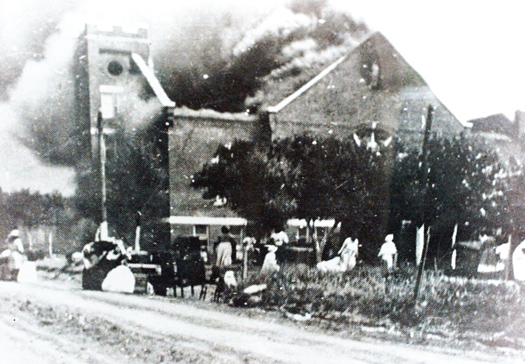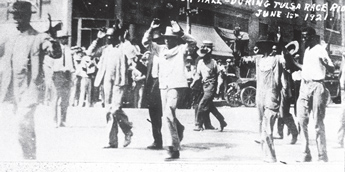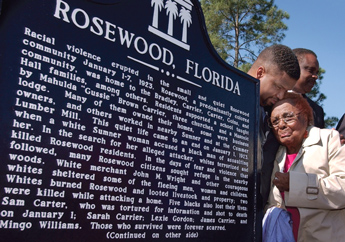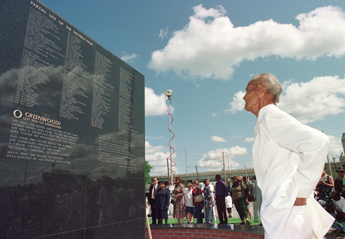
(FinalCall.com) – Bombs were dropped in America in 1921 but they weren’t part of an aerial attack by a foreign invader, they were incendiary devices dropped by those intent on destroying a prosperous Black community in the Greenwood section of Tulsa, Oklahoma, and removing any traces of what resourceful Black people had accomplished.
Black Wall Street commemorations were being held across the United States to mark racial assaults that began late May 31 and continued into June 1, 1921.
Because of the racial discrimination prevalent at the time, Blacks were relegated to limited areas for shopping and land ownership. According to the Greenwood Chamber of Commerce, the area, also known as “Little Africa” encompassed over 400 businesses and housed 11,000 residents. Residents included well-educated Blacks who were doctors, lawyers and had earned advanced degrees.

However anyone desiring to obtain an education, start a business, raise a family or anything other than servitude was a threat to the existing White social, economic and political order.
In that environment and economic reality Black entrepreneurs, professionals and the poor aided and patronized one another in Tulsa, Oklahoma, said author and economist Cedric Muhammad.
“The Blacks who struggled and prospered in Oklahoma’s Black Wall Street knew an intense form of segregation which many of us today could not fathom,” said Mr. Muhammad. “That painful reality created a circumstance of suffering and limited freedom which forced a level of unity and social cohesion that laid a foundation for economic independence. The entire community–regardless of class, ideology or status–found itself bound together in the same condition,” he added.
During the violent attacks, a 35-square block area of Black-owned homes and thriving Black businesses were torched by a savage mobs of angry Whites, after rumors spread that a White woman, 17-year-old Sarah Page, was the victim of an attempted rape in the Drexel Building near the town center by 19-year-old Black man Dick Rowland.

On the morning of May 31, Mr. Rowland was arrested by Tulsa police and taken to jail. Things became even more dangerous for Mr. Rowland after the Tulsa Tribune–one of two newspapers in the city–reported the incident. What was printed was inflammatory given the racial climate and the journalistic style of the newspaper, however, what was exactly reported is a mystery. According to the official report by the Oklahoma Commission to Study the Tulsa Race Riot of 1921:
“Precisely what the Tulsa Tribune printed in its May 31, 1921 editions about the Drexel Building incident is still a matter of some conjecture. The original bound volumes of the now defunct newspaper apparently no longer exist in their entirety.
A microfilm version is, however, available, but before the actual microfilming was done some years later, someone had deliberately torn out of the May 31, 1921 city edition both a front-page article and, in addition, nearly all of the editorial page.”
Anger began to rise; confusion grew in light of the growing racial standoff. Mr. Rowland’s adoptive mother, Damie Ford, immediately hired a prominent White attorney to defend him. According to the historical record, approximately 2,000 Whites assembled outside where he was held ready to lynch him. Black men, numbering approximately 75, showed up to protect the young man’s life. Ultimately, the teenager was declared innocent of the rape, but violence erupted that had been simmering just under the surface. Jealous and insecure Whites had been waiting for an opportunity to destroy Black progress.
While the official report of the riot at the time reported only 36 people killed, the Race Riot Commission said up to 300 were killed. Still others say the number of dead is much higher, perhaps more than 3,000 because many bodies of the Black victims were never recovered.
A still suffering community?
Living in America and receiving the typical Western education, most have heard of business titans such as John D. Rockefeller, Cornelius Vanderbilt, Andrew Carnegie and J.P. Morgan. Between the Civil War through the Great Depression and on through the end of World War I, the American landscape was economically transformed. In addition to the oil, steel, shipping, automobile, and finance industries, America’s business titans governed, cotton was also a huge source of wealth.
At the start of the 20th century, Blacks had over 16 million acres of land. You don’t hear about how coming out of chattel slavery that 60 all-Black towns were set up in America.

Jim Crow laws did not simply keep Blacks and Whites from using the same facilities and eating in the same restaurants. Jim Crow laws prevented Blacks from obtaining property, starting businesses or involving themselves in trade and commerce to develop economic independence.
The painful and debilitating effects of Jim Crow are still being felt today, and the collective economic character of the Black community suffers as an unintended consequence of the strategy of integration.
“A primary difference between our communities today and those of that era is that now, the environment which would compel our economic adjustment and change of behavior is missing. So, we truly are not forced to unite with one another.
This is why integration was especially deceptive in economic terms. When we integrated we traded financial independence for social liberty and when we did that our dollars no longer circulated within the economic body of our community,” said economist Cedric Muhammad.
In today’s rancorous political environment, it is common to hear calls for Blacks to “pull themselves up by their own bootstraps.” The implication is those experiencing trouble starting businesses or establishing thriving economies in areas where Blacks hold demographic dominance is due to a lack of desire or perhaps lack of competence.
This is a mischaracterization of present day realities, said Paul Scott, a Durham-based writer, lecturer and activist. Durham N.C. is actually considered by many to be the first Black Wall Street business district up until 1920. The legacy of Black Wall Street has been diminished by the failed strategy of integration, urban neglect, with many areas marked for gentrification.
“I think we have constantly–in our righteous nature–underestimated the lengths that the European will go to stop our progress and to protect their self-interests,” Mr. Scott noted.
In the 1990s, Durham N.C. became a “ghost-town.” Then developers came in and began to buy up the land. Land speculators and business owners from outside the area labeled the community as drug-filled and crime infested, and unfortunately, many Black people bought into that notion, said Mr. Scott.
The Durham area once known as “Black Wall Street” is now filled with White tourists and by his estimate less than 10 percent of the businesses are owned by Blacks.
“Our trash became their treasure,” Mr. Scott said, “The proverbial ‘boys in the hood’ became the hipsters in the ‘hood.’ It is not gangsters with pit bulls, it is hipsters with poodles.”
Racism, discrimination and destruction
On January 26, 1877, and again on February 7, 1877 the American Banking Association met to discuss the country’s financial future. Part of that discussion focused on Black people “freed” from chattel slavery and how it disrupted profit making schemes.
After 12-years of “emancipation” Blacks were returned to an insidious form of virtual slavery and relegated to prolonged, persistent economic, political, and social inferiority that still exists. This is not a coincidence. Each time Black people worked to establish economic power; they were targeted for death and destruction.
Discriminatory practices by large financial institutions continue until this very day. Bank of America was recently fined $2.2 million for discriminating against Black job applicants over a period of two decades. Merrill Lynch also recently reached a settlement to pay $160 million after a federal class action lawsuit was brought by Black brokers in 2005 and there are many more instances of discrimination. Many Black business districts have suffered with huge corporations buying up land, displacing residents who once formed their customer base.
In addition to Black Wall Street in Oklahoma, there was Rosewood, Fla., where former slaves erected businesses and governed their political and economic affairs. What is historically known as the Rosewood Massacre took place in January 1923 when racist Whites–again behind spurious allegations that a White woman was raped–attacked the prosperous predominately Black area’s residents even lynching one man. The Blacks of Rosewood armed themselves to defend against attack from Whites who heavily outnumbered them.
In different parts of the United States, domestic terrorism by the Ku Klux Klan was sanctioned by economic and political leaders because many were members and had no qualms about destroying Black people or Black institutions. Black-owned businesses were regularly targeted for destruction causing massive loss of investment dollars, sales, and profits. Many times, Black-owned businesses were uninsured and because of the racist policies of American insurance companies, once a Black business was destroyed, that was it.
Trying to heal in Oklahoma?
There have been efforts to promote some healing in the aftermath of the shameful episode in Oklahoma. In 1996 the Tulsa Race Riot Commission was formed to provide an historical account of the events which transpired. A report was delivered on February 28, 2001 with recommendations for sizeable restitution for Blacks who were victimized.
“It was a tragic, infamous moment in Oklahoma and the nation’s history. The worse civil disturbance since the Civil War,” wrote Tulsa State Representative Don Ross in the prologue of the report. “It happened. There was murder, false imprisonment, forced labor, a cover-up, and local precedence for restitution. While the official damage was estimated at $1.5 million, the black community filed more than $4 million in claims. All were denied.”
At the time, there was no effort to deliver restitution to Black landowners and business owners, nor were any Whites held responsible for the “reign of terror.” Rep. Ross said, “Justice demands a closure as it did with Japanese Americans and Holocaust victims of Germany. It is a moral obligation.”
Some of those recommended actions aimed at healing the racial wounds involved direct payments to survivors of the 1921 race riot as well as their descendants, the establishment of a scholarship fund and the creation of economic empowerment zones and public memorials for the victims in the Greenwood District, where much of the violence transpired and where fires burned.
In search of solutions for Black America
During a 2011 appearance in Pittsburgh, Penn., at an annual town hall meeting hosted by talk show host Bev Smith, the Honorable Minister Louis Farrakhan addressed the problem of “The Disappearing Black Community and How We Can Get It Back.” Historically, when Blacks get together to discuss economics, meddling Jewish organizational leaders object, and this was no exception. Despite their anger, Min. Farrakhan forthrightly addressed the issue.

“We, as elders, have some fault in this matter: When we could integrate, when we could go into the finest establishments and eat wonderful meals and socialize, we took our minds off of the prize. I read that when the NAACP, the Urban League, and other Black organizations were established, the thought behind those who helped to found these organizations was for Blacks to have a benign economic liberalism,” Min. Farrakhan noted.
“In other words, even though Blacks could fight for rights, we could not become economically self-sufficient, because the benefit was for others to take our money for providing the services that we are not providing for ourselves,” he added.
We can create clean, economically viable progressive Black-controlled and owned communities, however there has to be an attitude adjustment, said experts and Black economic advocates.
Cedric Muhammad recommends studying the rotating savings and credit traditions of Chinese, Japanese, West African and Jamaican communities as well as the free-loan societies of the Jewish community. He also recommended a study of the success of Black communities in Durham, N.C., and Richmond, Va. The Economic Blueprint of the Most Honorable Elijah Muhammad and its re-introduction by Minister Farrakhan is a key factor that can make saving and pooling of resources not only an inter-generational activity but a lot of fun, Cedric Muhammad said.
“Intellectually, while we do know more today than 93-years-ago, that superior knowledge of self, others and technology has not been activated by a circumstance that compels us to do for self, as they, in Greenwood, Okla., once did,” said Mr. Muhammad. “Even the vast majority of us who know better won’t do better because our intellect and knowledge does not have the power to break the emotional attachment we have to integration. Our love for another civilization’s political and cultural identity is connected to a denial of our independent economic identity. There is still a psychological and emotional chain that has to be broken in order for us to change,” he added.
Whether in politics, economics or crime prevention, there is often a disconnect preventing collective advancement and properly dealing with these pressing issues, added Rev. Otis Moss III of Trinity United Church of Christ. “We have not had a connection between strategy and implementation; practitioner and theorist. We’ve always had the separation,” said Rev. Moss. “There has to be a strong connection and coalition for those who are doing the work and also those who are doing the theory and those who are doing policy formation.”












